Pituitary gland
In vertebrate anatomy, the pituitary gland, or hypophysis, is an endocrine gland, about the size of a pea and weighing 0.5 grams (0.018 oz) in humans. It is a protrusion off the bottom of the hypothalamus at the base of the brain. The hypophysis rests upon the hypophysial fossa of the sphenoid bone in the center of the middle cranial fossa and is surrounded by a small bony cavity (sella turcica) covered by a dural fold (diaphragma sellae).[2] The anterior pituitary (or adenohypophysis) is a lobe of the gland that regulates several physiological processes (including stress, growth, reproduction, and lactation). The intermediate lobe synthesizes and secretes melanocyte-stimulating hormone. The posterior pituitary (or neurohypophysis) is a lobe of the gland that is functionally connected to the hypothalamus by the median eminence via a small tube called the pituitary stalk (also called the infundibular stalk or the infundibulum).
| Pituitary gland | |
|---|---|
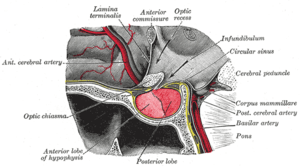 Located at the base of the brain, the pituitary gland is protected by a bony structure called the sella turcica of the sphenoid bone. | |
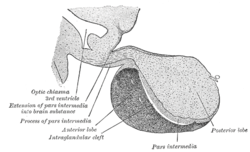 Median sagittal through the hypophysis of an adult monkey. Semidiagrammatic. | |
| Details | |
| Precursor | neural and oral ectoderm, including Rathke's pouch |
| Artery | superior hypophyseal artery, infundibular artery, prechiasmal artery, inferior hypophyseal artery, capsular artery, artery of the inferior cavernous sinus[1] |
| Identifiers | |
| Latin | hypophysis, glandula pituitaria |
| MeSH | D010902 |
| NeuroLex ID | birnlex_1353 |
| TA | A11.1.00.001 |
| FMA | 13889 |
| Anatomical terms of neuroanatomy | |



Hormones secreted from the pituitary gland help to control growth, blood pressure, energy management, all functions of the sex organs, thyroid glands and metabolism as well as some aspects of pregnancy, childbirth, breastfeeding, water/salt concentration at the kidneys, temperature regulation and pain relief.
Structure
The pituitary gland, in humans, is a pea-sized gland that sits in a protective bony enclosure called the sella turcica. It is composed of three lobes: anterior, intermediate, and posterior. In many animals, these three lobes are distinct. The intermediate is avascular and almost absent in human beings. The intermediate lobe is present in many animal species, in particular in rodents, mice and rats, that have been used extensively to study pituitary development and function.[3] In all animals, the fleshy, glandular anterior pituitary is distinct from the neural composition of the posterior pituitary, which is an extension of the hypothalamus.[3]
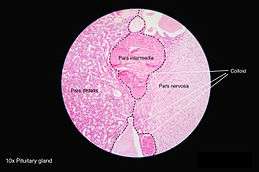
Anterior
The anterior pituitary arises from an invagination of the oral ectoderm and forms Rathke's pouch. This contrasts with the posterior pituitary, which originates from neuroectoderm.
Endocrine cells of the anterior pituitary are controlled by regulatory hormones released by parvocellular neurosecretory cells in the hypothalamic capillaries leading to infundibular blood vessels, which in turn lead to a second capillary bed in the anterior pituitary. This vascular relationship constitutes the hypothalamo-hypophyseal portal system. Diffusing out of the second capillary bed, the hypothalamic releasing hormones then bind to anterior pituitary endocrine cells, upregulating or downregulating their release of hormones.[4]
The anterior lobe of the pituitary can be divided into the pars tuberalis (pars glandularis) and pars distalis (pars glandularis) that constitutes ~80% of the gland. The pars intermedia (the intermediate lobe) lies between the pars distalis and the pars tuberalis, and is rudimentary in the human, although in other species it is more developed.[3] It develops from a depression in the dorsal wall of the pharynx (stomal part) known as Rathke's pouch.
The anterior pituitary contains several different types of cells[5] that synthesize and secrete hormones. Usually there is one type of cell for each major hormone formed in anterior pituitary. With special stains attached to high-affinity antibodies that bind with distinctive hormone, at least 5 types of cells can be differentiated.
| S.No. | Type of cell | Hormone secreted | Percentage of type of cell |
|---|---|---|---|
| 1. | Somatotropes | human growth hormone (hGH) | 30-50% |
| 2. | Corticotropes | adrenocorticotropin (ACTH) | 20% |
| 3. | Thyrotropes | thyroid stimulating hormone (TSH) | 3–5% |
| 4. | Gonadotropes | gonadotropic hormone i.e., both luteinizing hormone (LH) and follicle stimulating hormone (FSH) | 3–5% |
| 5. | Lactotropes | prolactin (PRL) | 3–5% |
Posterior
The posterior lobe develops as an extension of the hypothalamus. The posterior pituitary hormones are synthesized by cell bodies in the hypothalamus. The magnocellular neurosecretory cells, of the supraoptic and paraventricular nuclei located in the hypothalamus, project axons down the infundibulum to terminals in the posterior pituitary. This simple arrangement differs sharply from that of the adjacent anterior pituitary, which does not develop from the hypothalamus.
The release of pituitary hormones by both the anterior and posterior lobes is under the control of the hypothalamus, albeit in different ways.[4]
Functions
Anterior
The anterior pituitary synthesizes and secretes hormones. All releasing hormones (-RH) referred to, can also be referred to as releasing factors (-RF).
- Human growth hormone (HGH), also referred to as 'growth hormone' (GH), and also as somatotropin, is released under the influence of hypothalamic growth hormone-releasing hormone (GHRH), and is inhibited by hypothalamic somatostatin.
- Cleaved from the precursor proopiomelanocortin protein, and include adrenocorticotropic hormone (ACTH), and beta-endorphin, and melanocyte-stimulating hormone are released under the influence of hypothalamic corticotropin-releasing hormone (CRH).[6][7]:1210
- Thyroid-stimulating hormone (TSH), is released under the influence of hypothalamic thyrotropin-releasing hormone (TRH) and is inhibited by somatostatin.
- Luteinizing hormone (LH).
- Follicle-stimulating hormone (FSH), both released under influence of Gonadotropin-releasing Hormone (GnRH)
- Prolactin (PRL), whose release is inconsistently stimulated by hypothalamic TRH, oxytocin, vasopressin, vasoactive intestinal peptide, angiotensin II, neuropeptide Y, galanin, substance P, bombesin-like peptides (gastrin-releasing peptide, neuromedin B and C), and neurotensin, and inhibited by hypothalamic dopamine.[8]
These hormones are released from the anterior pituitary under the influence of the hypothalamus. Hypothalamic hormones are secreted to the anterior lobe by way of a special capillary system, called the hypothalamic-hypophysial portal system.
There is also a non-endocrine cell population called folliculostellate cells.
Intermediate
The intermediate lobe synthesizes and secretes the following important endocrine hormone:
- Melanocyte–stimulating hormone (MSH). This is also produced in the anterior lobe.[9] When produced in the intermediate lobe, MSHs are sometimes called "intermedins".
Posterior
The posterior pituitary stores and secretes (but does not synthesize) the following important endocrine hormones:
- Antidiuretic hormone (ADH, also known as vasopressin and arginine vasopressin AVP), the majority of which is released from the supraoptic nucleus in the hypothalamus.
- Oxytocin, most of which is released from the paraventricular nucleus in the hypothalamus. Oxytocin is one of the few hormones to create a positive feedback loop. For example, uterine contractions stimulate the release of oxytocin from the posterior pituitary, which, in turn, increases uterine contractions. This positive feedback loop continues throughout labour.
Hormones
Hormones secreted from the pituitary gland help control the following body processes:
- Growth (GH)
- Blood pressure
- Some aspects of pregnancy and childbirth including stimulation of uterine contractions
- Breast milk production
- Sex organ functions in both sexes
- Thyroid gland function
- Metabolic conversion of food into energy
- Water and osmolarity regulation in the body
- Water balance via the control of reabsorption of water by the kidneys
- Temperature regulation
- Pain relief
Clinical significance
Some of the diseases involving the pituitary gland are:
- Central diabetes insipidus caused by a deficiency of vasopressin
- Gigantism and acromegaly caused by an excess of growth hormone in childhood and adult, respectively
- Hypothyroidism caused by a deficiency of thyroid-stimulating hormone
- Hyperpituitarism, the increased (hyper) secretion of one or more of the hormones normally produced by the pituitary gland
- Hypopituitarism, the decreased (hypo) secretion of one or more of the hormones normally produced by the pituitary gland
- Panhypopituitarism a decreased secretion of most of the pituitary hormones
- Pituitary tumours
- Pituitary adenomas, noncancerous tumors that occur in the pituitary gland
All of the functions of the pituitary gland can be adversely affected by an over- or under-production of associated hormones.
The pituitary gland is important for mediating the stress response, via the hypothalamic–pituitary–adrenal axis (HPA axis) Critically, pituitary gland growth during adolescence can be altered by early life stress such as childhood maltreatment or maternal dysphoric behavior.[10]
It has been demonstrated that, after controlling for age, sex, and BMI, larger quantities of DHEA and DHEA-S tended to be linked to larger pituitary volume.[11] Additionally, a correlation between pituitary gland volume and Social Anxiety subscale scores was identified which provided a basis for exploring mediation. Again controlling for age, sex, and BMI, DHEA and DHEA-S have been found to be predictive of larger pituitary gland volume, which was also associated with increased ratings of social anxiety.[11] This research provides evidence that pituitary gland volume mediates the link between higher DHEA(S) levels (associated with relatively early adrenarche) and traits associated with social anxiety.[11] Children who experience early adrenarcheal development tend to have larger pituitary gland volume compared to children with later adrenarcheal development.[11]
History
Etymology
Pituitary gland
The Greek physician Galen referred to the pituitary gland by only using the (Ancient Greek) name ἀδήν,[12] gland.[13] He described the pituitary gland as part of a series of secretory organs for the excretion of nasal mucus.[12] Anatomist Andreas Vesalius translated ἀδήν with glans, in quam pituita destillat, "gland in which slime (pituita[14]) drips".[12][15] Besides this 'descriptive' name, Vesalius used glandula pituitaria, from which the English name pituitary gland[16] is ultimately derived.
The expression glandula pituitaria is still used as official synonym beside hypophysis in the official Latin nomenclature Terminologia Anatomica.[17] In the seventeenth century the supposed function of the pituitary gland to produce nasal mucus was debunked.[12] The expression glandula pituitaria and its English equivalent pituitary gland can only be justified from a historical point of view.[18] The inclusion of this synonym is merely justified by noting that the main term hypophysis is a much less popular term.[19]
Hypophysis
The anatomist Samuel Thomas von Sömmerring coined the name hypophysis.[12] This name consists[12][18] of ὑπό ('under')[13] and φύειν ('to grow').[13] In later Greek ὑπόφυσις is used differently by Greek physicians as outgrowth.[12] Sömmering also used the equivalent expression appendix cerebri,[12][15] with appendix as appendage.[14] In various languages, Hirnanhang[15] in German and hersenaanhangsel[20] in Dutch, the terms are derived from appendix cerebri.
Other animals
The pituitary gland is found in all vertebrates, but its structure varies among different groups.
The division of the pituitary described above is typical of mammals, and is also true, to varying degrees, of all tetrapods. However, only in mammals does the posterior pituitary have a compact shape. In lungfish, it is a relatively flat sheet of tissue lying above the anterior pituitary, but in amphibians, reptiles, and birds, it becomes increasingly well developed. The intermediate lobe is, in general, not well developed in any species and is entirely absent in birds.[21]
The structure of the pituitary in fish, apart from the lungfish, is generally different from that in other animals. In general, the intermediate lobe tends to be well developed, and may equal the remainder of the anterior pituitary in size. The posterior lobe typically forms a sheet of tissue at the base of the pituitary stalk, and in most cases sends irregular finger-like projection into the tissue of the anterior pituitary, which lies directly beneath it. The anterior pituitary is typically divided into two regions, a more anterior rostral portion and a posterior proximal portion, but the boundary between the two is often not clearly marked. In elasmobranchs there is an additional, ventral lobe beneath the anterior pituitary proper.[21]
The arrangement in lampreys, which are among the most primitive of all fish, may indicate how the pituitary originally evolved in ancestral vertebrates. Here, the posterior pituitary is a simple flat sheet of tissue at the base of the brain, and there is no pituitary stalk. Rathke's pouch remains open to the outside, close to the nasal openings. Closely associated with the pouch are three distinct clusters of glandular tissue, corresponding to the intermediate lobe, and the rostral and proximal portions of the anterior pituitary. These various parts are separated by meningial membranes, suggesting that the pituitary of other vertebrates may have formed from the fusion of a pair of separate, but associated, glands.[21]
Most armadillos also possess a neural secretory gland very similar in form to the posterior pituitary, but located in the tail and associated with the spinal cord. This may have a function in osmoregulation.[21]
There is a structure analogous to the pituitary in the octopus brain.[22]
Intermediate lobe
Although rudimentary in humans (and often considered part of the anterior pituitary), the intermediate lobe located between the anterior and posterior pituitary is important to many animals. For instance, in fish, it is believed to control physiological color change. In adult humans, it is just a thin layer of cells between the anterior and posterior pituitary. The intermediate lobe produces melanocyte-stimulating hormone (MSH), although this function is often (imprecisely) attributed to the anterior pituitary.
The intermediate lobe is, in general, not well developed in tetrapods, and is entirely absent in birds.[21]
 Location of the pituitary gland in the human brain
Location of the pituitary gland in the human brain Pituitary and pineal glands
Pituitary and pineal glands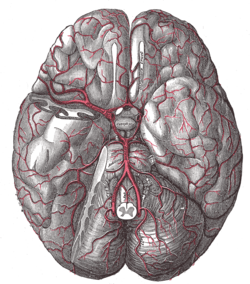 The arteries of the base of the brain.
The arteries of the base of the brain.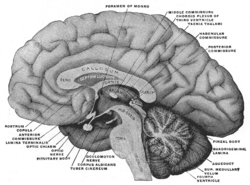 Mesal aspect of a brain sectioned in the median sagittal plane.
Mesal aspect of a brain sectioned in the median sagittal plane. Pituitary
Pituitary Pituitary gland
Pituitary gland- Cerebrum.Inferior view.Deep dissection.
See also
References
- Gibo H, Hokama M, Kyoshima K, Kobayashi S (1993). "[Arteries to the pituitary]". Nippon Rinsho. 51 (10): 2550–4. PMID 8254920.
- Mancall, Elliott L.; Brock, David G., eds. (2011). "Cranial Fossae". Gray's Clinical Anatomy. Elsevier Health Sciences. p. 154. ISBN 9781437735802.
- Melmed, Shlomo (2011). The Pituitary - (Third Edition). San Diego, CA 92101-4495, USA: Academic Press is an imprint of Elsevier. pp. 23–25. ISBN 978-0-12-380926-1.CS1 maint: location (link)
- Boron, Walter F.; Boulpaep, Emile L. (2009). Medical Physiology (2nd ed.). Philadelphia: Saunders Elsevier. pp. 1016–1017. ISBN 978-1-4160-3115-4.
- Textbook of Medical Physiology. Elsevier Saunders.
- Knepel W, Homolka L, Vlaskovska M, Nutto D. (1984). Stimulation of adrenocorticotropin/beta-endorphin release by synthetic ovine corticotropin-releasing factor in vitro. Enhancement by various vasopressin analogs. Neuroendocrinology. 38(5):344-50.
- Brunton, Laurence L.; Chabner, Bruce A.; Knollmann, Björn C., eds. (2011). Goodman & Gilman's pharmacological basis of therapeutics (12th ed.). New York: McGraw-Hill. ISBN 978-0-07-162442-8.
- Shlomo Melmed (3 December 2010). The pituitary. Academic Press. p. 40. ISBN 978-0-12-380926-1.
- Pocock, Gillian (2006). Human Physiology (Third ed.). Oxford University Press. p. 193. ISBN 978-0-19-856878-0.
- Ganella, Despina E.; Allen, Nicholas B.; Simmons, Julian G.; Schwartz, Orli; Kim, Jee Hyun; Sheeber, Lisa; Whittle, Sarah (2015). "Early life stress alters pituitary growth during adolescence—A longitudinal study". Psychoneuroendocrinology. 53: 185–194. doi:10.1016/j.psyneuen.2015.01.005. PMID 25622011.
- Murray, CR; Simmons, JG; Allen, NB; Byrne, ML; Mundy, LK; Seal, ML; Patton, GC; Olsson, CA; Whittle, S (February 2016). "Associations between dehydroepiandrosterone (DHEA) levels, pituitary volume, and social anxiety in children". Psychoneuroendocrinology. 64: 31–9. doi:10.1016/j.psyneuen.2015.11.004. PMID 26600008.
- Hyrtl, J. (1880). Onomatologia Anatomica. Geschichte und Kritik der anatomischen Sprache der Gegenwart. Wien: Wilhelm Braumüller. K.K. Hof- und Universitätsbuchhändler.
- Liddell, H.G. & Scott, R. (1940). A Greek-English Lexicon. revised and augmented throughout by Sir Henry Stuart Jones. with the assistance of. Roderick McKenzie. Oxford: Clarendon Press.
- Lewis, C.T. & Short, C. (1879). A Latin dictionary founded on Andrews' edition of Freund's Latin dictionary. Oxford: Clarendon Press.
- Schreger, C.H.Th.(1805). Synonymia anatomica. Synonymik der anatomischen Nomenclatur. Fürth: im Bureau für Literatur.
- Anderson, D.M. (2000). Dorland’s illustrated medical dictionary (29th edition). Philadelphia/London/Toronto/Montreal/Sydney/Tokyo: W.B. Saunders Company.
- Federative Committee on Anatomical Terminology (FCAT) (1998). Terminologia Anatomica. Stuttgart: Thieme
- Triepel, H. (1927). Die anatomischen Namen. Ihre Ableitung und Aussprache. Anhang: Biographische Notizen.(Elfte Auflage). München: Verlag J.F. Bergmann.
- International Anatomical Nomenclature Committee (1966). Nomina Anatomica. Amsterdam: Excerpta Medica Foundation, p. 62
- Pinkhof, H. (1923). Vertalend en verklarend woordenboek van uitheemsche geneeskundige termen. Haarlem: De Erven F. Bohn.
- Romer, Alfred Sherwood; Parsons, Thomas S. (1977). The Vertebrate Body. Philadelphia, PA: Holt-Saunders International. pp. 549–550. ISBN 0-03-910284-X.
- Wells, M. J.; Wells, J. (1969). "Pituitary Analogue in the Octopus". Nature. 222 (5190): 293–294. Bibcode:1969Natur.222..293W. doi:10.1038/222293a0. PMID 5778406.
External links
| Look up pituitary gland or hypophysis in Wiktionary, the free dictionary. |
| Wikimedia Commons has media related to Pituitary gland. |
- Pituitary gland at the Encyclopædia Britannica
- hier-382 at NeuroNames
- Histology image: 14201loa – Histology Learning System at Boston University
- The Pituitary Gland, from the UMM Endocrinology Health Guide
- Oklahoma State, Endocrine System
- The Pituitary Foundation
- The Pituitary Network Association -- pituitary.org